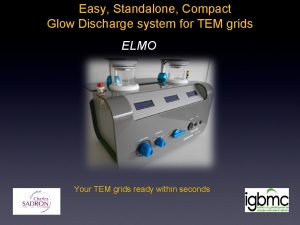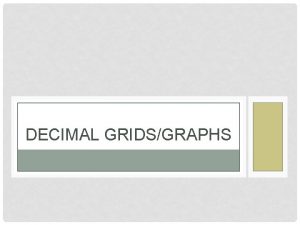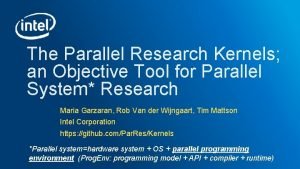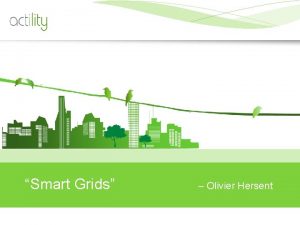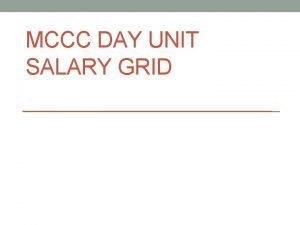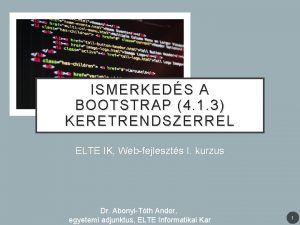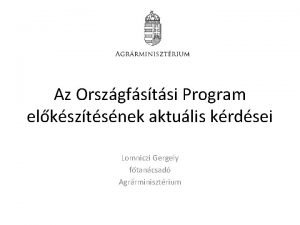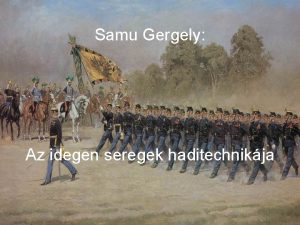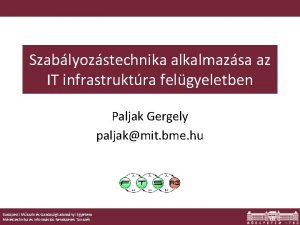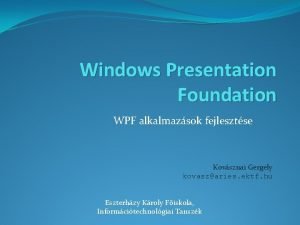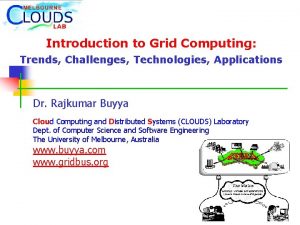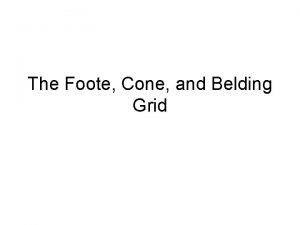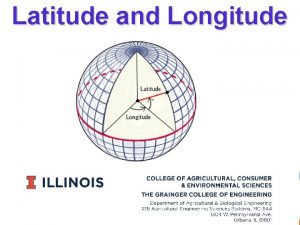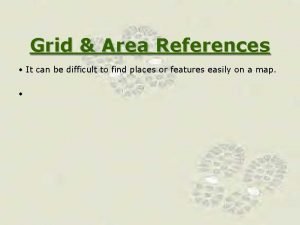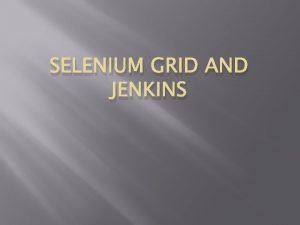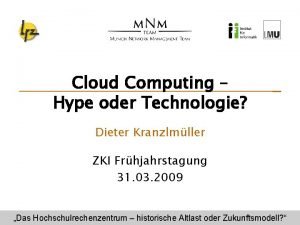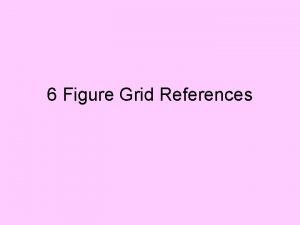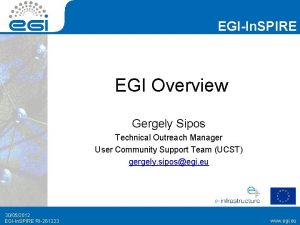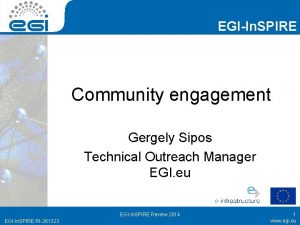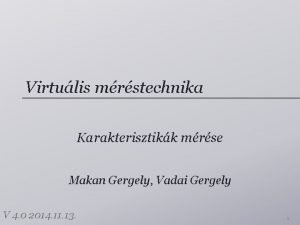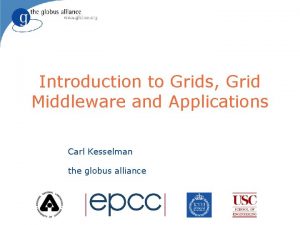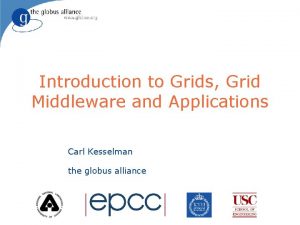Introduction to Grids and Grid applications Gergely Sipos















































- Slides: 47

Introduction to Grids and Grid applications Gergely Sipos MTA SZTAKI www. lpds. sztaki. hu sipos@sztaki. hu

What is Grid? ● ● A Grid is a collection of computers, storages, special devices, services that can dynamically join and leave the Grid They are heterogeneous in every aspect They are geographically distributed and connected by a wide-area network They can be accessed ondemand by a set of users Internet

Why use a Grid? • A user has a complex problem that requires many services/resources in order to • • Reduce computation time Access databases Share equipments Collaborate with other users Internet

Typical Grid application areas • Demand for computation capacity • High-performance computing (HPC) • Shorten the execution time of a single parallel application • Reguirement: parallel computing • High-throughput computing (HTC) • Execute as many similar jobs as possible during a given period • Requirement: exploit spare CPU cycles • Demand for large data storage • With the involvement of physically distributed data bases • Demand for collaborative work • Integrate several users’ knowledge in order to solve a complex problem

Example: Large Hidron Collider, CERN, Genf Mont Blanc (4810 m) ATLAS Downtown Geneva ~10 -15 Peta. Bytes /year ~108 events/year ~103 batch and interactive users LHCb CMS

Example: Rolls Royce aircraft engines 1 Gb data per engine per flight ● ● Real time download to basis airport Historical data mining ● ● Evaluation, analysis ● ● Across airports Pattern search on distributed platform Preparing maintenance crew

Other examples • In silico drug discovery – molecule simulations to find drug candidates • Earth science, space research – sharing, analyzing satellite pictures • Archeology – digital archives, virtual simulations • Weather prediction – data integration, model selection, simulations, evaluation • Engineering – simulation of buildings, vehicles in extreme conditions • . . .

Why to use grids? ● Most of these problems were solved by supercomputers and clusters 5 -10 years ago. Now grids are used: ● ● A Grid is able to utilize spare cycles without extra investments Grids can share risk, can lower participation cost Grids can integrate resources – HW, SW, data Grids provide flexible access to resources

Grid vision Mobile Access G R I D Workstation Visualising M I D D L E W A R E Supercomputer, PC-Cluster Data-storage, Sensors, Experiments Internet, networks

Problems to solve ● Standard access to resources ● ● ● Computers Storage resources Special devices Software Data Access policy, security Load balancing Monitoring of resources Monitoring of applications Error handling Application methodology, programming models. . .

If “The Grid” vision leads us here… … then where are we now? • • • Utility computing Cloud computing E-Infrastructure Cycle scavenging … IBM Grid HP Grid Oracle Grid …

Generic Grid modell Donating free resources Inst 1 Inst 2 Inst 4 Internet Requiring resources Inst 3

Two players of the Grid • Resource donors = D • Resource users = U • Relationship between the two characterizes the Grid: • if U ~ D generic Grid model • if U >> D utility Grid model • if U << D desktop Grid model

Generic Grid model is complex… ● Endless possible usage patterns Involved security solutions Real time information system Complex brokering, load balancing architecture Flexible programming architecture ● Simplifications were made to achieve something useful: ● ● ● Utility grids Desktop grids

Utility grids

Utility Grid model Inst 1 Donor and user User 1 Donating resources static 7/24 mode Internet Dynamic resource requirements Inst 2 Donor and user User N

Characteristics of the utility Grid model • Donors must be “professional” resource providers who provide production service (7/24 mode) Simplification • Homogeneous resources Simplification • Anybody can use the donated resources for solving her/his own applications • Asymmetric relationship between donors and users: U >> D

Utility Grid example: EGEE ● ● ● ● > 200 sites in 40 countries ~ 38 000 CPUs ~ 5 PB storage 98 k jobs/day > 200 Virtual Organizations g. Lite middleware The World’s largest multi-disciplinary Grid http: //www. eu-egee. org/

Utility Grid example: Open Science Grid 30 Virtual Organizations 105 Resources 26 Support Agencies Middleware: – Virtual Data Toolkit (VDT): collection of grid tools – – – http: //www. opensciencegrid. org/ Condor Globus VO Management Service

Utility Grid example: Nordu. Grid http: //www. nordugrid. org/ Dynamic Grid ~ 33 sites, ~1400 CPUS Production Grid – – – Applications from various scientific disciplines Sites operate 24/7 Mostly unattended by administrators Middleware: – Advanced Resource Connector (ARC)

Utility Grid example: UK National Grid Service ● http: //www. grid-support. ac. uk/ 4 core sites: Leeds, Oxford, Manchester, Rutherford ● 6 partner sites ● 3 affiliate sites ● Middleware: Globus Toolkit 2 ● Additional SW services: ● OGSA DAI ● Storage Resource Broker ● NGS Oracle DB ● P-GRADE Portal ● . . .

Virtual Organizations and Utility Grids • Grid: – Resources that host the same middleware version – People who use them • VO: – Logical subset of sites and users – Security policy – Dynamic? • Atlas VO tens of years • WISDOM data challenge few weeks Virtual Organization Grid

Virtual Organizations and Utility Grids • Grid: – Resources that host the same middleware version – People who use them • The Grid problem is to enable Virtual VO: “coordinated resource sharing – Logical of sites and solving andsubset problem in dynamic, Organization users multi-institutional. Grid virtual – Security policy organizations. ” – Dynamic? • Atlas VO tens of years • WISDOM data challenge From VO few weeks ”The Anatomy of the Grid” by Ian Foster, Carl Kesselman, Steven Tuecke

Utility Grids: Based on Service Oriented Architecture Registry Register an available service Send name & description Service Consumers Services

Architecture of Service Grids: Service Oriented Architecture Registry Request a service Send a description Service Consumers Services

Architecture of Service Grids: Service Oriented Architecture Registry Set (possibly empty) of matching services Service Consumers Services

Architecture of Service Grids: Service Oriented Architecture Registry Service Consumers Request service operation Services

Architecture of Service Grids: Service Oriented Architecture Registry Service Consumers Return result or Error Services

Architecture of Service Grids: Service Oriented Architecture Registries Server programs run on the resources • High availability is a must • Standard protocols expected • Security architecture is Services complicated Consumers • Requires expertise at every site

SOA meets the Grid Supercomputing (PVM/MPI) Clusters Network Computing (sockets) Cluster computing Web Computing (scripts) OO Computing (CORBA) Client/server High-throughput High-performance computing Condor Object Web Globus, LCG-2 Web Services Service Oriented Grids Semantic Grid Utility Grid Systems

Desktop Grids

Desktop Grid model Dynamic resource donation Company/ univ. server Donor: Company/ Univ. or private PC Application Internet Donor: Company/ univ. or private PC Work package distribution

Characteristics of the desktop Grid model • Anybody can donate resources • Heterogeneous resources, that dynamically join and leave • One or a small number of projects can use the resources Simplification • Resources run clients: Expertise only at the server Simplification • Asymmetric relationship between donors and users: U << D • Advantage: • Donating a PC is extremely easy • Setting up and maintaining a DG server is much easier than installing the server sw of utility grids

Types of Desktop Grids • Global Desktop Grid • Aim is to collect resources for grand-challenge scientific problems • Example: • BOINC (SETI@home) • Local Desktop Grid • Aim is to enable the quick and easy creation of grid for any community (company, univ. city, etc. ) to solve their own applications • Example: • SZTAKI Desktop Grid

SETI: a global desktop grid ● SETI@home ● 3. 8 M users in 226 countries ● 1200 CPU years/day ● ● ● 38 TF sustained (Japanese Earth Simulator is 32 TF sustained. Currently 30 rd on TOP 500) Highly heterogeneous: >77 different processor types Infrastructure is separated now from application: BIONC

SZTAKI Desktop Grid: a global and local DG system • Extension of BOINC • • Simplifies the creation of DG applications Simplifies the installation and maintenance of DG servers Global and local configuration Global installation: http: //www. lpds. sztaki. hu/desktopgrid/ • Mathematical problem: Search for number dimension • Installation package is available • Three steps to try and use the system: 1. Donate one PC to the Global system 2. Port application to the global system 3. Set up a DG for your own community Step 1 is easy. SZTAKI helps in steps 2 and 3

FP 7 Project - EDGe. S ● ● ● Enabing Desktop Grids for e-Science Two years, started on the 1 st of January, 2008. Integrate Desktop Grids and Utility Grids ● ● ● Including BIONC and g. Lite technologies (besides other DG tools) DG jobs UG UG jobs DG ● Integrated portal environment to develop and manage applications on DG, UG platforms Coordinator MTA SZTAKI, Hungary – www. lpds. sztaki. hu ● Watch for news at www. edges-grid. eu ●

Programming the grid

Available parallelism in grids • Utility Grids – Master-slave (parameter study) – Inter-site parallelism – Intra-site parallelism – Workflow – Combination of the above • Desktop Grids – Master-slave (parameter study)

Master-slave (parameter study) parallelism Master Work package 1 Work package 2 Work package 3 Work package N Internet

Inter-site parallelism Internet

Intra-site parallelism Internet

Workflow parallelism Internet

Combined parallelism Example: Inter-site and parameter study Internet

Goal of the course ● ● ● This is not a middleware developer course This is a user course specialised on g. Lite and related technologies. Why g. Lite? ● ● A utility grid implementation Anybody can access to execute applications Widely used, well supported, large community behind it Several potential use cases Several extra tools „around” it

Conclusion • Generic grid model is good, but hard to implement • Simplification in practice: • Utility grids • Desktop grids • Existing production installation from both types • EGEE, US OSG, Nordu. Grid, UK NGS Various patterns • BOINC, SZTAKI DG Master-slave • Course focus on • Utility grids • g. Lite middleware and related tools • Application development and usage, installation, administration

Thank you for the attention ? sipos @ sztaki. hu
 Sipos gergely
Sipos gergely Sipos zsolt
Sipos zsolt Sipos botond
Sipos botond Tanja kalman šipoš
Tanja kalman šipoš Layered architecture for web services and grids
Layered architecture for web services and grids Off center grid
Off center grid Glow discharge system
Glow discharge system Decimal using grids
Decimal using grids Parallel research kernels
Parallel research kernels Demand response in smart grids
Demand response in smart grids Mccc salary grid
Mccc salary grid Bootstrap 4 osztály
Bootstrap 4 osztály Differentiation grids
Differentiation grids North bridge south bridge
North bridge south bridge Egri csillagok csillag motívum
Egri csillagok csillag motívum Gergely ágnes énekesnő
Gergely ágnes énekesnő Lomniczi gergely
Lomniczi gergely Nathan verhelst
Nathan verhelst Eduverzum
Eduverzum Cseh gergely
Cseh gergely Idegen gergely
Idegen gergely Dexmathason
Dexmathason Gergely paljak
Gergely paljak Gosztonyi gergely
Gosztonyi gergely Gecse gergely
Gecse gergely Kovásznai gergely
Kovásznai gergely Grid computing applications
Grid computing applications Grid computing introduction
Grid computing introduction Grid computing introduction
Grid computing introduction Introduction to grid computing
Introduction to grid computing Management myths in software engineering
Management myths in software engineering Application of heat transfer
Application of heat transfer Image sets
Image sets Body paragraph structure
Body paragraph structure Foote cone belding
Foote cone belding Who invented latitude and longitude grid system
Who invented latitude and longitude grid system Area reference example
Area reference example Trench excavation calculation
Trench excavation calculation Advantages and disadvantages of cloud database
Advantages and disadvantages of cloud database Describe the dunn's high level wellness grid
Describe the dunn's high level wellness grid Dr nabil khouri
Dr nabil khouri Selenium grid with jenkins
Selenium grid with jenkins Likes dislikes puzzles connections grid
Likes dislikes puzzles connections grid Worksheet c latitude and longitude the grid system
Worksheet c latitude and longitude the grid system The terms grid linear quadrant zone and spiral
The terms grid linear quadrant zone and spiral Sketch preparer
Sketch preparer Grid and cloud computing lmu
Grid and cloud computing lmu 4 figure and 6 figure grid references
4 figure and 6 figure grid references






